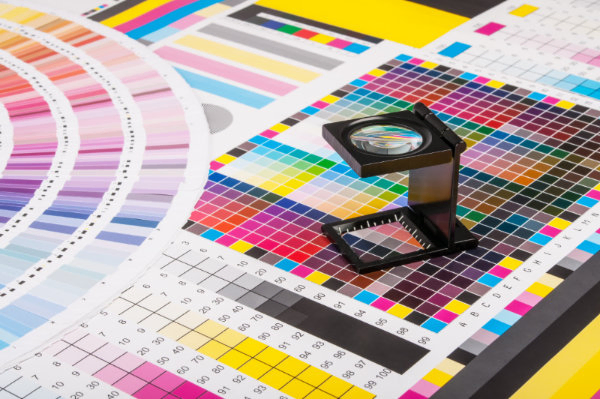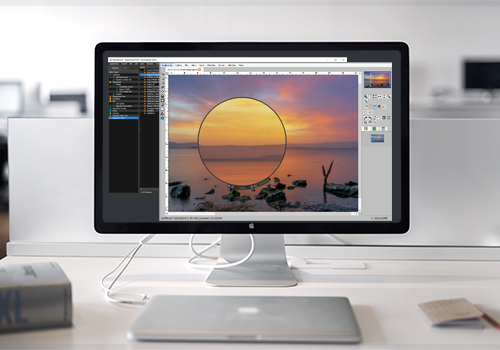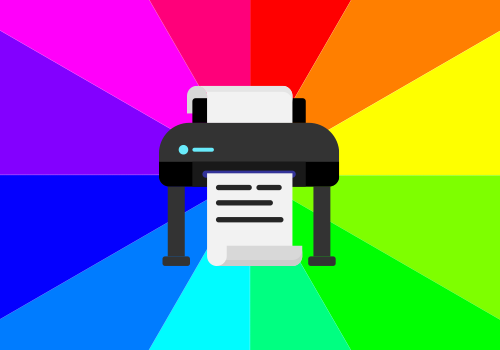Soft Proofing with RIP Software: A Preview of Printed Colours
In the world of design and printing, achieving accurate colour representation is the cornerstone of producing stunning visual content. However, this task can be incredibly challenging due to the inherent differences between digital screens and physical prints. This is where the concept of soft proofing comes into play.
What is Soft Proofing?
Soft proofing plays a vital role in the design and print industry by providing a virtual sneak peek into how a digital design will appear in its final printed format. It essentially offers a digital preview of your design as it will look on paper or any other tangible medium.
Here's a breakdown of the key aspects of soft proofing:
- Digital Simulation: Soft proofing allows designers and print professionals to preview how a design will look when it's printed by providing a visual representation on a computer screen.
- Colour Accuracy: Soft proofing aims to achieve accurate colour representation, ensuring that the colours you see on your screen closely match the final printed output.
- Preemptive Adjustments: By soft proofing, designers can identify and address any discrepancies or issues with colours, layout, or other design elements before sending a project to print. This helps prevent costly errors and reprints.
- Digital Workflow: In modern digital workflows, soft proofing is a key component that enhances efficiency by diminishing the requirement for physical proofs and slashing turnaround times in design and printing processes.
In the print industry, soft proofing plays a pivotal role in achieving accuracy, uniformity, and productivity. It empowers designers to make informed decisions, ensures alignment between the final print and their creative vision, and contributes to cost savings and sustainability by minimising material wastage.
Serendipity's Blackmagic, Megarip, and Veripress solutions seamlessly integrate soft proofing into the overall print workflow, offering a centralised platform for file preparation, colour management, and previewing. This unified approach eliminates the need for switching between separate applications, streamlining the process and enhancing efficiency.
Key Features of RIP Software for Soft Proofing
Let's explore a few key attributes and capabilities of RIP software, which play a pivotal role in this workflow.
Colour Translation and Calibration: One of the primary functions of RIP software is to translate digital colours accurately into the CMYK (Cyan, Magenta, Yellow, Black) colour space. It ensures that the vibrant hues you see on your computer screen will be faithfully reproduced on the printed page. Moreover, RIP software enables precise colour calibration, accounting for variations in different printing devices, inks, and paper types. This calibration helps achieve consistent and predictable colour output, regardless of the printing equipment used.

Colour Profiles and Rendering Intent: It allows users to define and manage colour profiles, which are essential in soft proofing. Colour profiles provide a standardised framework for mapping colours across different devices and media, ensuring a seamless transition from screen to print. Rendering intent is another critical aspect managed by RIP software. It determines how colours that are out of gamut (colours that cannot be faithfully reproduced in print) are adjusted to fit within the gamut of the chosen output device.
Spot Colour Management: Spot colours are specific ink colours, such as Pantone colours, used for branding and precise colour matching. RIP software ensures that spot colours are accurately reproduced, maintaining brand consistency and quality.
These key features collectively empower designers and print professionals to leverage RIP software for soft proofing, enabling them to achieve unparalleled colour accuracy, consistency, and efficiency in their projects. With the right software, the soft proofing process becomes a cornerstone of high-quality and cost-effective printing practices.
Benefits of Soft Proofing with RIP Software
Soft proofing with RIP software offers a myriad of advantages:
- Enhanced Colour Accuracy and Consistency: One of the most significant advantages of soft proofing with RIP software is the remarkable improvement in colour accuracy and consistency. By precisely translating digital colours into the CMYK space and managing colour profiles, the software ensures that what you see on your screen closely aligns with the final printed output. This leads to a reduction in costly reprints and a higher level of client satisfaction.
- Time and Cost Savings: Soft proofing streamlines the entire design and printing workflow. It eliminates the need for time-consuming and costly physical proofs, allowing designers and print professionals to make colour adjustments on-screen before sending a job to print. This not only accelerates project turnaround times but also reduces material wastage and labour costs.
- Real-time Feedback: RIP software provides real-time feedback, allowing designers to make instant colour corrections. This means that adjustments can be made quickly, without the need for time-consuming back-and-forth iterations.

- Consistent Branding: For businesses that rely on consistent branding, RIP software ensures that spot colours and corporate identity colours are faithfully reproduced. This consistency is vital for maintaining brand integrity and recognition across various print materials, from marketing collateral to packaging.
- Error Reduction: The automation and precision offered significantly reduce the chances of errors in the printing process. Designers can spot and rectify issues during the soft proofing stage, avoiding costly mistakes in the final print. This not only saves money but also preserves a professional reputation.
- Improved Workflow Efficiency: The ability of the software to handle batch processing and automate repetitive tasks enhances overall workflow efficiency. Print professionals can seamlessly manage multiple jobs, optimising production schedules and maximising output capacity.
- Environmentally Friendly: Reducing the need for physical proofs and minimising paper wastage through efficient job nesting and layout optimisation also contributes to a more environmentally friendly printing process.
In summary, soft proofing with colour-managed RIP software empowers designers and print professionals with the tools needed to achieve unparalleled colour accuracy, streamline workflows, reduce costs, and uphold branding consistency.
Integration with Other Tools: Enhancing Workflow Efficiency
In addition to its primary functions, RIP software offers seamless integration into existing design and printing workflows. This compatibility with other software and hardware solutions is a key factor in enhancing efficiency and productivity.
Compatibility with Design Software: It is designed to work harmoniously with popular design software packages such as Adobe Creative Suite, including Photoshop, Illustrator, and InDesign. This means that designers can effortlessly export their creations from these applications directly into RIP software for soft proofing and printing.

Colour Management Integration: For precise colour calibration, the software can be integrated with colour management tools and devices such as spectrophotometers. This integration ensures that colours are accurately reproduced across different devices, a crucial requirement in maintaining colour consistency.
Cross-Platform Compatibility: The software is designed to be cross-platform, compatible with various operating systems such as Windows, Linux, and macOS. This flexibility accommodates different IT environments, making it accessible to a wide range of users.
Device Simulation and Testing: Some RIP software goes beyond basic soft proofing and offers device simulation capabilities. This allows users to preview how their designs will appear on different printing devices and substrates.
Colour Correction and Proof-to-Print Matching: Many software solutions include colour correction tools to fine-tune colours, matching them precisely to the final printed output. This feature is particularly useful for achieving the utmost colour accuracy. Designers can rely on RIP software to ensure that what they see on their screens will closely align with the printed results.
Incorporating RIP software into your existing toolkit empowers you to take full advantage of its compatibility with other tools. This translates into a more efficient, time-saving workflow, improved colour accuracy, and ultimately, higher-quality printed materials.
Challenges and Limitations
While soft proofing with RIP software offers a multitude of benefits, it's essential to be aware of potential challenges and limitations that may arise during the process.
- Monitor Discrepancies: One common challenge is monitor discrepancies. Even with calibration, there may be variations in how different monitors display colours. This can impact the accuracy of your soft proof, particularly if you're collaborating with others using different screens. To mitigate this, consider using monitors with high-quality colour reproduction and maintaining consistency among team members.
- Device and Media Variability: RIP software can do wonders in managing colour profiles, but it may not completely eliminate variability in different printing devices and media. Factors such as the age and maintenance of equipment, variations in ink or toner quality, and different paper stocks can still influence colour accuracy. Regularly updating and maintaining your printing equipment can help mitigate these issues.
- Limited Gamut: Soft proofing has its limits when it comes to reproducing colours that fall outside the gamut of your chosen output device. Some colours on your screen may not be achievable in print due to technical constraints. Understanding the gamut of your printing equipment and choosing colours accordingly can help you work within these limitations.
- Complexity of Settings: The software typically provides a wide array of settings and choices. Although these options offer versatility, they can be daunting. Therefore, it's crucial to dedicate time to comprehend and refine these settings for optimal outcomes.
Despite these challenges, the benefits of soft proofing with RIP software far outweigh the limitations. By continuously learning, and adapting your workflow, you can effectively address these challenges and consistently achieve remarkable colour accuracy in your printing projects.
Unlock Precision
As we delve deeper into the realm of digital design and printing, soft proofing with RIP software emerges as an indispensable tool, empowering designers and print professionals to achieve unparalleled colour accuracy, streamline workflows, reduce costs, and uphold branding consistency.
Embracing the power of RIP software for soft proofing unlocks a new era of colour fidelity and creative expression, paving the way for stunning visual creations that seamlessly bridge the digital and physical worlds.



